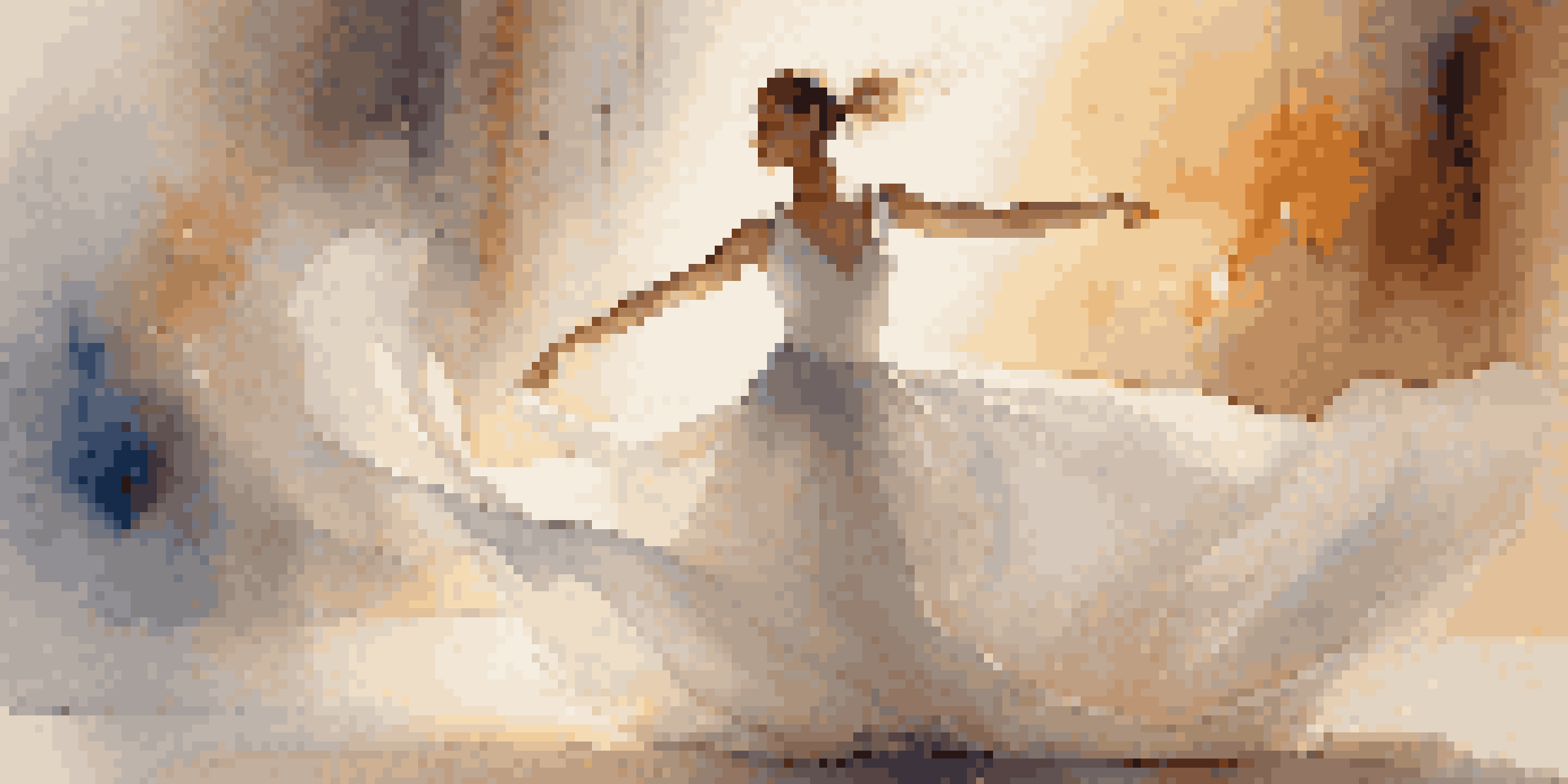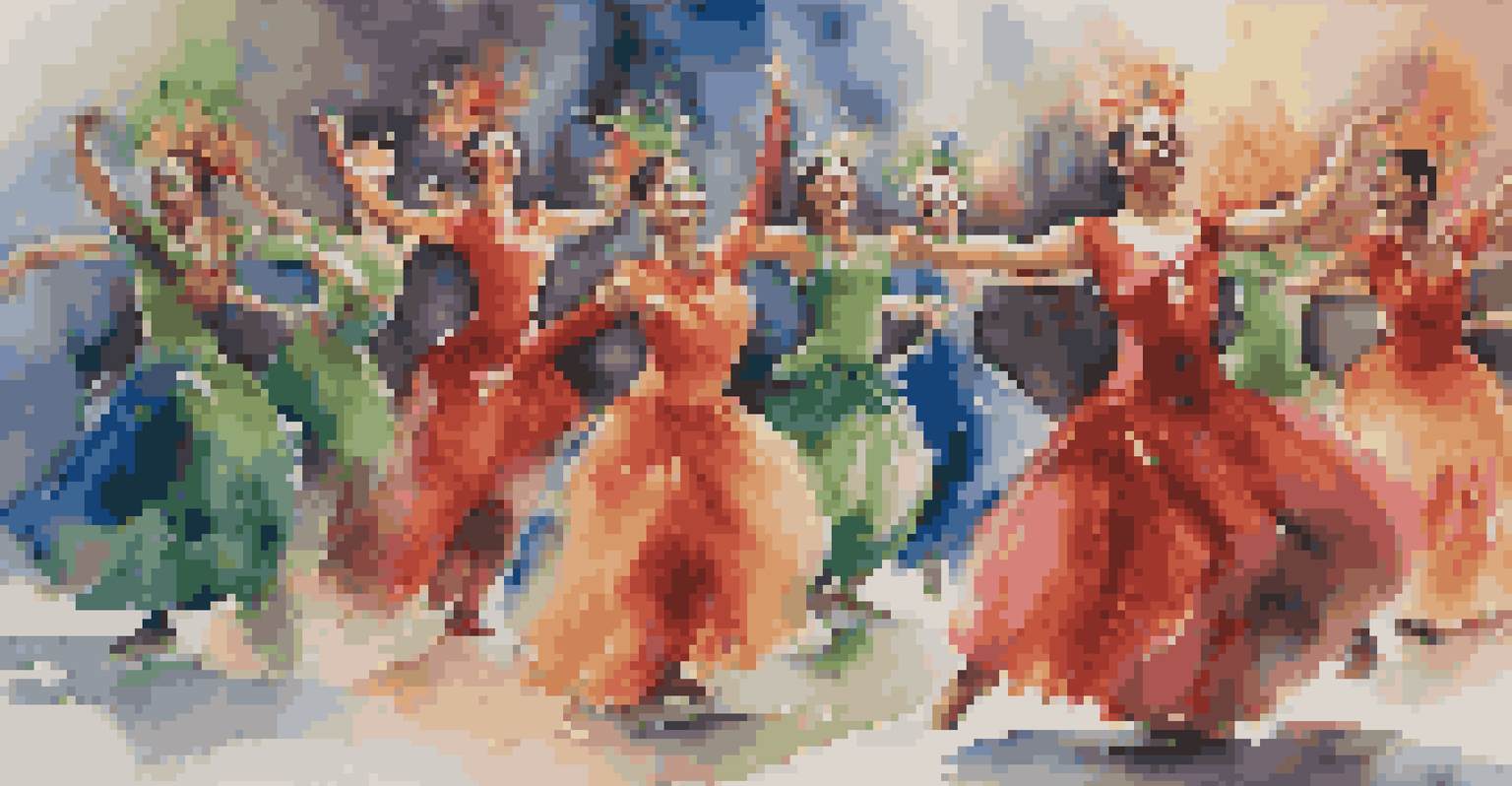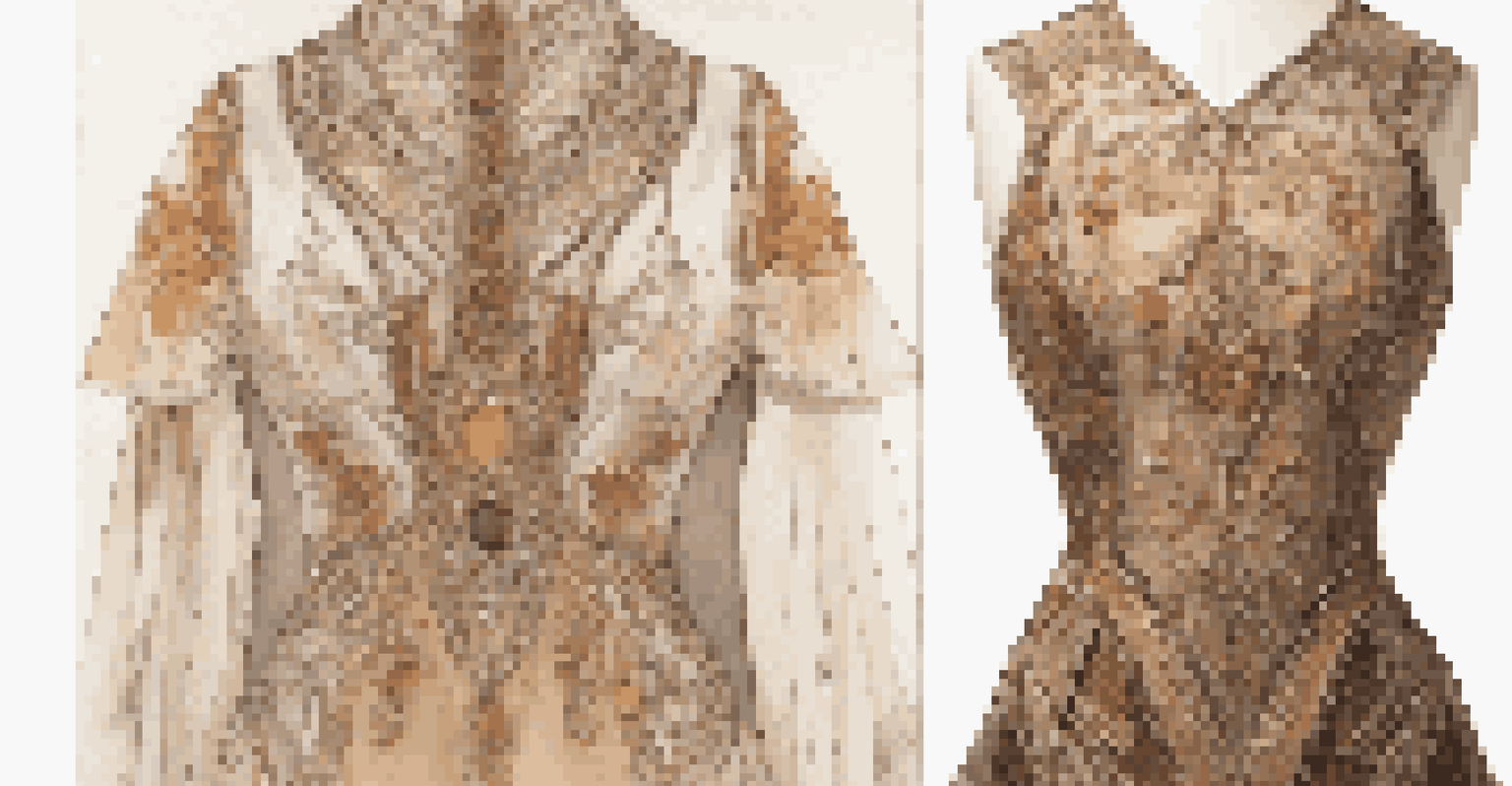The Narrative Power of Costume in Dance Storytelling

Understanding Costume's Role in Dance Narratives
Costumes in dance are not just fabric; they are a crucial storytelling element. They help communicate the character's emotions, background, and journey, often before a single move is made. When dancers wear vibrant colors, flowing fabrics, or intricate designs, they instantly convey messages about their roles and relationships in the story.
Costumes are the visual language of dance; they speak volumes about the character's journey even before the music begins.
For instance, a dancer in a flowing white gown might evoke purity or innocence, while a performer in darker shades could suggest mystery or danger. This visual language allows audiences to connect with the narrative on a deeper level, making the dance more impactful. Ultimately, the right costume can transform a simple performance into a rich narrative experience.
Moreover, the synergy between movement and costume can amplify emotions. As a dancer spins, the fabric may swirl and catch the light, enhancing the story being told. This interplay of movement and attire creates a captivating spectacle that resonates with the audience long after the curtain falls.
Historical Context of Costume in Dance
To appreciate the narrative power of costumes in dance, it's essential to understand their historical evolution. From early ballet performances featuring elaborate tutus to contemporary dance that embraces minimalism, the role of costume has shifted dramatically. Each era reflects the cultural and artistic values of its time, influencing how stories are portrayed through movement.

In traditional ballet, for example, costumes were meticulously designed to represent specific characters, often derived from fairy tales or classic literature. These costumes not only depicted the character's essence but also adhered to the strict aesthetic standards of the time. Over the years, however, choreographers began to experiment with more abstract and modern designs, allowing for greater freedom of expression.
Costumes Convey Dance Narratives
Costumes play a vital role in storytelling by visually representing characters' emotions and backgrounds.
This evolution signifies a broader narrative in dance; as society changes, so do the ways in which stories are told on stage. Modern dance often challenges conventions, using costumes to provoke thought and invite interpretation. This flexibility encourages audiences to engage with the narrative in a more personal and subjective manner.
Symbolism in Dance Costumes
Costumes serve as powerful symbols in dance storytelling, often representing themes, emotions, or societal issues. For instance, a dancer clad in red may signify passion or conflict, while earthy tones could represent a connection to nature or tradition. These colors and styles create a visual shorthand that helps audiences grasp complex ideas quickly.
The costume should be an extension of the dancer's body, enhancing the storytelling rather than overshadowing it.
Consider a performance centered around social justice; the use of monochromatic outfits can symbolize unity or oppression, reinforcing the theme without the need for words. This symbolic potential enhances the storytelling, allowing the audience to interpret the narrative through the lens of their own experiences and emotions.
Moreover, when costumes are layered with cultural significance, they can deepen the narrative. A dance inspired by a specific cultural tradition can use traditional garments to honor that heritage, inviting viewers to appreciate the history and stories woven into the fabric. Thus, costumes become an essential part of the narrative tapestry.
The Emotional Impact of Costume Choices
The emotional resonance of a dance performance can be significantly influenced by costume choices. When a dancer wears an outfit that aligns with their character's emotions, it creates a more authentic connection with the audience. This emotional synergy can elevate the performance, making the story not just seen but felt.
For example, a dancer portraying grief in a tattered, dark outfit can evoke empathy and sorrow from the audience. Conversely, a character experiencing joy might don bright, flowing attire, spreading a sense of happiness that is palpable in the atmosphere. This direct correlation between costume and emotion enhances the storytelling experience.
Costume Choices Affect Emotions
The emotional impact of a performance is heightened when costumes align with the characters' feelings, enhancing audience connection.
Additionally, the psychological effect of costumes extends to the performers themselves. Dancers often feel empowered or transformed when they wear their costumes, which can lead to more dynamic and expressive performances. This internal connection to their attire allows them to embody their characters fully, further enriching the narrative.
Costume Design and Collaboration in Dance
Creating effective costumes for dance performances is often a collaborative process involving choreographers, designers, and dancers. This teamwork ensures that the costumes align with the overall vision of the performance while also considering practicality and movement. After all, a beautiful costume must also allow for the freedom of expression that dance requires.
Designers often work closely with choreographers to understand the narrative and emotional tone of the piece. They consider factors like fabric choice, color palette, and overall silhouette to ensure the costumes not only look stunning but also serve the story. This collaboration can lead to innovative designs that enhance the storytelling in unexpected ways.
Moreover, dancers contribute their insights during this process, providing feedback on how the costume feels during movement. This input is invaluable, as it ensures that the costumes not only represent the character but also support the dancer's ability to perform effectively. The end result is a harmonious blend of art and functionality.
The Audience's Interpretation of Costume Narratives
One of the fascinating aspects of costume in dance is how audiences interpret visual cues uniquely. While a choreographer may have a specific narrative intention, each viewer brings their own experiences and perspectives, leading to diverse interpretations. This subjectivity enriches the overall storytelling experience.
For instance, a simple costume change during a performance might be seen as a transition between different emotional states or even different characters. An audience member may interpret a dancer's costume as a reflection of their personal struggles, while another might see it as a celebration of triumph. This multiplicity of meanings adds depth to the narrative.
Collaboration Shapes Costume Design
Creating effective dance costumes is a collaborative effort that ensures artistic vision and practicality are seamlessly integrated.
Ultimately, this interpretative aspect reinforces the idea that dance is a universal language. Costumes act as bridges, connecting the dancer's intent with the audience's perception. Through these visual elements, stories transcend spoken words, allowing for a shared experience that resonates across cultural and personal boundaries.
Future Trends in Dance Costuming
As dance continues to evolve, so too does the role of costume in storytelling. Future trends may see a greater emphasis on sustainability and innovation, with designers exploring eco-friendly materials and techniques. This shift reflects a growing awareness of environmental issues and the desire to create art that respects the planet.
Additionally, advancements in technology are likely to influence costume design. Imagine costumes that incorporate LED lights or responsive fabrics that change color based on movement or emotion. These innovations could usher in a new era of immersive storytelling, where the visual aspect of dance becomes even more dynamic and engaging.

Furthermore, as global influences continue to shape dance, we can expect a rich tapestry of cultural narratives to emerge through costumes. The blending of different styles and traditions will create opportunities for fresh interpretations and storytelling methods. This ever-changing landscape ensures that the narrative power of costume in dance will remain a vital and exciting element for years to come.